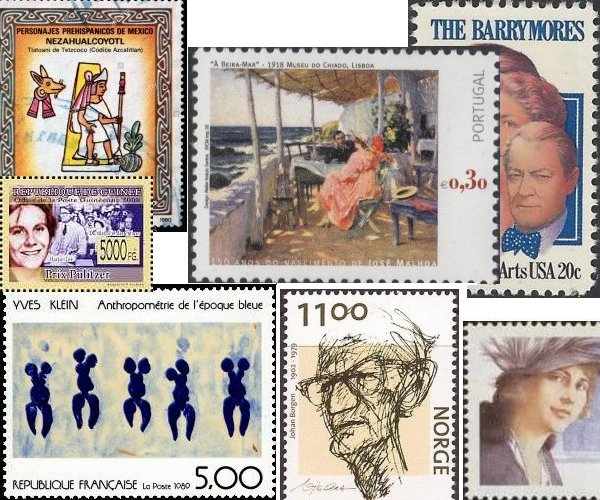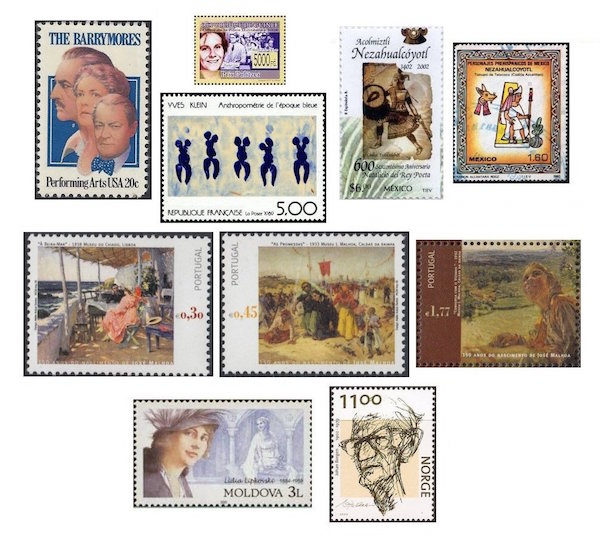The Arts on the Stamps of the World — April 28
An Arts Fuse regular feature: the arts on stamps of the world.

By Doug Briscoe
Today we salute Lionel Barrymore, Harper Lee, Yves Klein, and 15th-century Nahuatl poet and king Nezahualcoyotl, along with Portuguese painter José Malhoa and Norwegian writer Johan Borgen. April 28 may also be the birthday of Polish soprano Lidia Lipkovska.
Lionel Barrymore (born Lionel Herbert Blythe; April 28, 1878 – November 15, 1954) started making movies around 1911 with D.W. Griffith. His most famous roles would come years later: the odious Mr. Potter in It’s a Wonderful Life (1946), the honorable and courageous James Temple in Key Largo (1948), Dr. Gillespie in nine of the Dr. Kildare films. Every year WHRB (95.3FM, whrb.org) broadcasts his Ebenezer Scrooge (Barrymore reenacted this role annually for the last twenty years of his life.) One aspect of Barrymore’s life that surprised me was his work as a composer, artist, and novelist. He wrote orchestral and piano pieces, authored an historical novel, Mr. Cantonwine: A Moral Tale (1953), and made many etchings and drawings.
Apart from To Kill a Mockingbird, published in 1960, the late Harper Lee (April 28, 1926 – February 19, 2016) left only some stories and articles and the ill-received Go Set a Watchman, written in the ’50s but withheld from publication until 2015. What a shame that after a lifetime of admiration she had to suffer brickbats less than a year before the end of her long life! The US will, I’m certain, honor her with a stamp sooner or later; in the meantime we have this one from the Republic of Guinea (sorry for the tiny image—it’s the only one I could find) from a sheet of Pulitzer Prize winners. (I could buy a copy of the sheet and make a better scan, but at ten bucks forget about it!)
Both of the parents of Yves Klein (28 April 1928 – 6 June 1962) were painters. Though himself interested in painting from an early age, Klein was a judo enthusiast and at the age of 21 wrote a Monotone Symphony (1949), a 20-minute chord followed by 20 minutes of silence, a sort of precursor to Cage’s 4’33” (but multiplied by 4.4 with a prelude). His first public art exhibition was held the next year. Subsequent exhibits went from canvases of solid colors to canvases of one color (blue) to nothing: an empty studio painted white and entitled The Void. A later development, if you care to call it that, was the application of paint to canvas using the naked bodies of female models as “brushes”. This series Klein called Anthropométries, and one of them, Anthropométrie de l’époque bleue (1960), was selected for this Yves Klein postage stamp from 1989. There were other things later. Pour moi, cela suffit.

Prince Nezahualcoyotly Acolmiztli (Fasted Coyote, Arm of a Lion; born April 28, 1402) had to go into hiding at fifteen, when his father, the ruler of Texcoco, was assassinated, likely by his rivals, the Tepanecs of Azcapotzalco. Many years later he led a successful war against the Tepanecs and was crowned Tlatoani of Texcoco in 1431. His rule was characterized as wise and mild by the standards of the time and place (though capital punishment was enforced for many offenses), and he even built a temple in which human sacrifice was forbidden (progress of a sort, as all the other ones were permitted to go right ahead appeasing the gods). Nezahualcoyotl died on June 4, 1472, surrounded by his many concubines and over a hundred children (not including the four sons he had had executed for sleeping with the aforementioned concubines—one would think that doomed sons nos. 3 and 4 might have taken the hint). As for his poetry, it was passed on by oral tradition and annotated only by his great-grandson.
Portuguese painter José Malhoa (28 April 1855 – 26 October 1933) was accepted into the Lisbon Academy of Arts when he was 12. He became one of the leading naturalist painters (along with Columbano Bordalo Pinheiro) of his country. Two of his most celebrated canvases are The Drunkards (Os Bêbados, 1907) and Fado (1910), but neither of these was selected for his sesquicentennial stamps. Instead we have By the Sea (À Beira Mar, 1918), The Promises (As Promessas, 1920), and one of Malhoa’s last works, A Talk With the Neighbor (Conversa com o Vizinho, 1932).
According to Polish Wikipedia, Lidia Lipkovska (née Marszner) was born on April 28, 1884, but Grove Online gives her birthdate as June 6 (O.S. May 25), 1882. 1882 (month and day unspecified) is also cited on her English language Wikipedia page. She was born in the village of Babino in what was then part of the Russian Empire and sang at the Mariinsky Theatre from 1906 to 1913, with an interval at the Metropolitan Opera in New York from 1909 to 1911; her debut there was opposite Enrico Caruso in Verdi’s La Traviata. In those years she also appeared in Boston, Chicago, and London. She took part in the first performance in 1914 of Ponchielli’s posthumous opera I Mori di Valenza with Giovanni Martinelli. (This opera had been left unfinished at Ponchielli’s death in 1886 and was completed by Arturo Cadore and premièred in Monte Carlo.) Lipkovska left the Soviet Union in 1920 and enjoyed an international career until her retirement in 1936. She lived and taught in Romania until being evacuated during the war to Odessa, where she directed the conservatory until 1944. Virginia Zeani was one of her students. She spent her later years living in Bucharest, Paris, and finally Beirut, where she died on March 22, 1958.
Yesterday, you may recall, was the birthday of Norwegian writer Arnulf Øverland, whose anti-Nazi poems earned him a spell in Sachsenhausen. A similar fate befell Johan Borgen (28 April 1902 – 16 October 1979), whose articles, written under a pseudonym, finally caught up with him. Like Øverland he was interned at a concentration camp, albeit the relatively mild one of Grini in Norway. Borgen escaped and fled to Sweden. Born in Kristiania (Oslo), he had been a journalist until publishing his first story collection at 23. The first novel followed in 1934, succeeded over the decades by eight more story collections and over a dozen novels, the best known being Lillelord (1955), along with seven plays, criticism, and memoirs.
A graduate of the University of Massachusetts with a B.A. in English, Doug Briscoe worked in Boston classical music radio, at WCRB, WGBH, and WBUR, for about 25 years, beginning in 1977. He has the curious distinction of having succeeded Robert J. Lurtsema twice, first as host of WGBH’s weekday morning classical music program in 1993, then as host of the weekend program when Robert J.’s health failed in 2000. Doug also wrote liner notes for several of the late Gunther Schuller’s GM Recordings releases as well as program notes for the Boston Classical Orchestra. For the past few years he’s been posting a Facebook “blog” of classical music on stamps of the world, which has now been expanded to encompass all the arts for The Arts Fuse.

